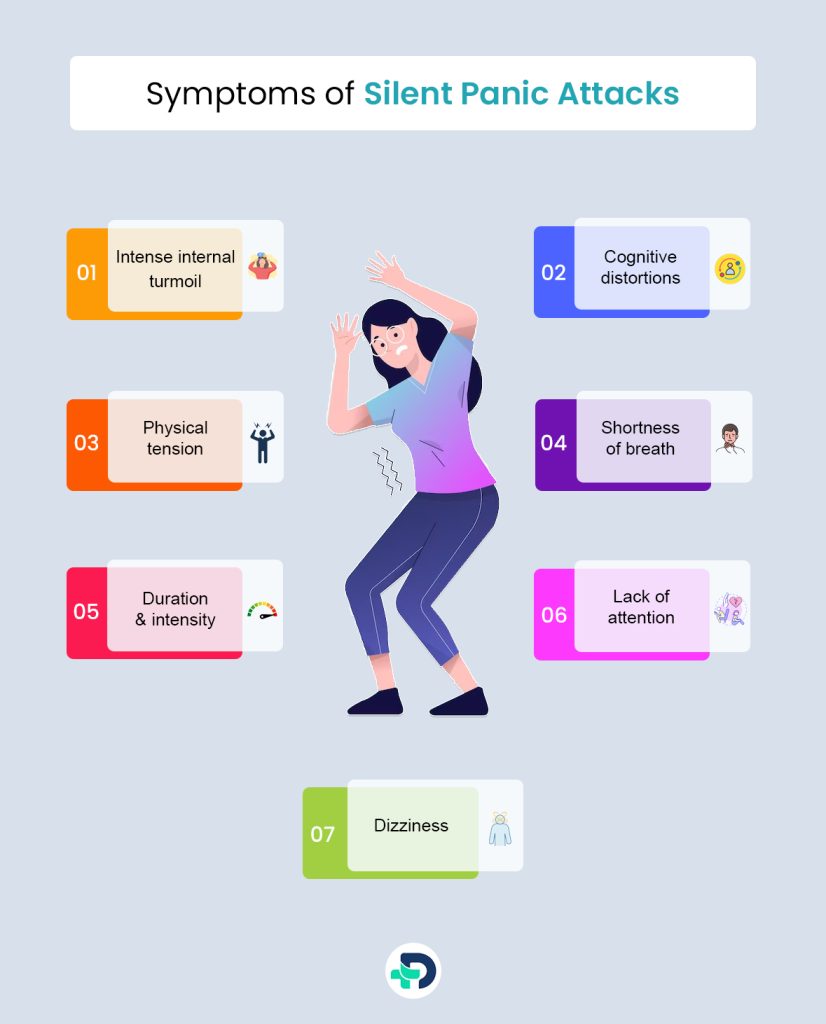Understanding & Coping With Silent Panic Attacks

- Panic Disorder
- 03 Oct 2023
Introduction
Panic Attacks
Panic attacks are detected as dramatic and highly visible episodes characterized by rapid breathing, racing hearts, and uncontrollable fear. However, not all panic attacks unfold in such a dramatic fashion. There exists a hidden and often misunderstood variant known as silent panic attacks. These episodes are stealthy, insidious, and, as the name suggests, silent in their manifestation. They are particularly challenging and isolating experiences for those who suffer from them.

In this article, we will delve into the world of silent panic attacks, shedding light on what they are, how to recognize them, their potential causes, and most importantly, how to cope with and seek support for these often invisible battles. While silent panic attacks may not make as much attention as their more overt counterparts, their impact on mental health and overall well-being should not be underestimated. Understanding, recognizing, and addressing it is essential to fostering empathy, support, and healing for those who go through the same. 1 Introduction | Researched based study from National Institutes of Health
Symptoms

Symptoms of Silent Panic Attacks
How can I tell I am having a panic attack?
Silent panic attacks can be challenging to identify as they lack the typical physical symptoms commonly associated with traditional panic attacks.
Symptoms of Silent Panic Attack
- Intense internal turmoil
- Physical tension
- Cognitive distortions
- Shortness of breath
- Dizziness or lightheadedness
Here is detailed information on the signs and symptoms listed above:
Intense internal turmoil:
- Unlike external displays of panic, silent panic attacks often manifest as intense internal turmoil. Individuals experiencing them may describe feeling overwhelmed by fear and distress on the inside while appearing calm on the outside.
Cognitive distortions:
- Distorted thoughts and catastrophic thinking can dominate the mind. This may include irrational fears of impending doom despite no apparent external threat.
Physical tension:
- While the physical symptoms are less noticeable, they can still cause muscle tension, particularly in the neck, shoulders, or jaw.
Shortness of breath:
- Some people may experience subtle changes in their breathing patterns, such as shallow breathing or an increased respiration rate.
Dizziness
- It can lead to feelings of dizziness or lightheadedness, though these sensations are typically less severe than in traditional panic attacks. 1 Symptoms | Researched based study from National Institutes of Health , 2 Symptoms | Researched based study from National Institutes of Health
How they differ from conventional panic attacks?
It’s essential to distinguish silent panic attacks from traditional ones as they have distinct characteristics:
External appearance
- Traditional ones are more outwardly visible. While someone experiencing a classic panic attack may hyperventilate, tremble, or cry out, those with silence often maintain a composed exterior.
Lack of attention
- Due to their subtle nature, silent panic attacks may go unnoticed by others, including friends, family, or coworkers. Feelings of loneliness and difficulty getting help may result from this.
Duration and intensity
- They can vary in duration, severity, and magnitude. They may be more prolonged and less intense than traditional ones, but this can vary from person to person. 2 Symptoms | Researched based study from National Institutes of Health
Types
Types of Panic Attacks
Unexpected panic attacks
- These occur without an Apparent Trigger or warning. They can happen anytime and often feel like they come out of the blue.
Situationally bound panic attacks
- Specific situations of phobias trigger these. For instance, a person who is afraid of flying can have a panic attack when boarding.
Situationally predisposed panic attacks
- Panic attacks that are more likely to happen in particular conditions even though they are not directly prompted by them. A person with social anxiety, for instance, might be more prone to attacks in social situations.
Limited symptoms of panic attacks
- Fever symptoms categorize these compared to a full-blown panic attack. Limited symptom attacks might involve a subset of panic symptoms such as rapid heartbeat or dizziness.
Nocturnal panic attack
- These occur during sleep and can wake people with intense fear and panic. Nocturnal panic attacks can be particularly distressing due to their unexpected nature.
Expected panic attacks
- Cases where someone anticipates a panic attack often due to a known trigger or phobia, these are considered expected.
Panic attacks with agoraphobia
- It frequently entails a fear of having panic episodes in public or in circumstances where escaping would be difficult. They are associated with avoidance behaviors.
Situational phobias
- While not always panic attacks in the traditional sense, some people experience extreme fear and anxiety related to specific situations or objects, such as flying, heights, or enclosed spaces. 4 Types | Researched based study from National Institutes of Health
Causes
Causes for Silent Panic Attacks
Why do I have silent panic attacks?
Understanding the underlying factors and common precipitants of silent panic attacks is crucial for effectively addressing and managing these episodes. Explore what contributes to the occurrence of them.
Underlying Factors:
Anxiety disorders
- Silent panic episodes are more common in those with anxiety disorders like generalized anxiety disorder or social anxiety disorder. These episodes often stem from the underlying anxiety condition.
Trauma & PTSD
- Past traumatic experiences can lead to the development of silent panic attacks. People who suffer from post-traumatic stress disorder may be seen as living monuments to tragic experiences.
Genetics
- Evidence suggests that a history of anxiety or panic disorders may increase some people’s risk of panic attacks. A person’s genetic disposition may be important.
Neurochemical imbalance
- The start of panic attacks, especially silent ones, might be influenced by an imbalance in neurotransmitters like serotonin and norepinephrine. 3 Causes | Researched based study from National Health Service
Common precipitants
- High-stress surroundings and stressful life events, such as job stress, marital problems, and financial troubles, can make people more prone.
Social settings
- Social anxiety is a common trigger for silent panic attacks. Being in situations where one feels scrutinized or judged by others can lead to these episodes.
Isolation
- Loneliness and isolation can exaggerate the risk. Feeling disconnected from others can increase feelings of vulnerability and fear.
Substance use
- In rare situations, using particular chemicals, such as caffeine, alcohol, or recreational drugs, can cause or exacerbate silent panic episodes.
Physical health issue
- Chronic health conditions or illnesses can be sources of anxiety that lead to silent panic attacks, especially when accompanied by uncertainty about the future. 8 Causes | Researched based study from Research Gate , 7 Causes | Researched based study from Research Gate
Effects
The Impact on Mental Health
Although it may not be as obvious as typical panic episodes, their effect on mental health should not be understated. This section will explore the emotional toll and long-term consequences of these often hidden episodes.
Emotional toll
- Increased anxiety
- Depression
- Isolation
- Decreased quality of life
Increased anxiety
- It can intensify existing anxiety levels. People may become hyper-vigilant during the next episode, creating a cycle of fear.
Depression
- Frequent silent panic attacks can contribute to the development of versioning of depression. They can make you feel hopeless due to the ongoing mental distress they create.
Isolation and loneliness
- The hidden nature of these attacks can isolate people from their friends and family. The fear of being misunderstood or judged can lead to social withdrawal.
Decreases quality of life
- They may degrade a person’s general quality of life. Daily tasks could start to cause anxiety, which would make it challenging to fully enjoy life. 6 Effects | Researched based study from Research Gate
Long Term Consequences:
- Chronic anxiety disorder
- Health complications
- Negative coping mechanism
- Impaired relationships
Chronic anxiety disorders
- If left unaddressed, silent panic attacks can evolve into chronic anxiety is a disorder. They may become a recurring pattern that interferes with daily functioning.
Health complications
- Long-term stress from silent panic episodes can cause a number of medical concerns, such as heart problems, digestive problems, and impaired immune system.
Unhealthy ways of coping
- Some people may resort to unhealthy coping mechanisms like substances abuse or self-harm to manage the emotional distress caused by silent panic attack.
Impaired relationships
- The secrecy and isolation associated can strain relationships with loved ones as communication and emotional connection may deteriorate.
Coping strategies
- Learning how to cope with them is essential for people who experience them. This section will explore managing and reducing these episodes’ impact effectively. 7 Effects | Researched based study from Research Gate
Management
Management of Silent Panic Attacks
Breathing Exercises
Deep breathing
- During a quiet panic attack, deep, diaphragmatic breathing can soothe the nervous system. Take a calm, deep breath in with your nose, hold it for a moment, and then softly let it out through your mouth.
The 4-7-8 method
- This method is inhaling for four counts, holding for seven, and then exhaling for eight. It can promote relaxation and reduce anxiety.
Box breathing
- It entails inhaling, holding for an equal amount of time, exhaling, and holding again—typically for four seconds each. It’s a quick and easy method for taking back control of your breathing. 5 Management | Researched based study from National Institutes of Health
Meditation and Awareness
Mindfulness
- Mindfulness is the ability to be fully present and judgment-free in the moment. It enables people to step back from worried thoughts and observe them objectively.
Meditation
- Regular meditation can reduce overall anxiety levels and provide people with tools to manage them. Guided meditation apps and classes are readily available for beginners.
Progressive muscle relaxation
- This method promotes physical and mental calm by tensing and then relaxing certain muscle groups.
Seek Professional Help
Therapy
- Cognitive behavioral and exposure therapy are often effective in treating panic disorders, including silent panic attacks. A therapist can help people identify triggers and develop coping strategies.
Medication
- In some circumstances, a doctor’s prescription for medicine may be required to treat the symptoms. These may include anti-anxiety medications or antidepressants.
Support groups
- Getting involved in a support group might give you a sense of belonging and comprehension. It can be reassuring and empowering to discuss experiences with others who are dealing with comparable difficulties.
Alterations in way of life
- Professionals can offer guidance on lifestyle adjustment, such as managing stress, improving sleep, and adopting a balanced diet, which can contribute to overall well-being. 5 Management | Researched based study from National Institutes of Health
FAQs
Silent Panic Attacks – Frequently Asked Questions
How long do panic attacks last?
- The time frame varies greatly from person to person. Like traditional panic attacks, silent ones are characterized by intense anxiety and fear, but they may be like the more noticeable physical ones.
- On average, it typically lasts between 5 to 20 minutes. However, some people experience shorter or longer episodes.
Is panic attack mental illness?
- The panic attacks are not mental illnesses but symptoms or manifestations of an underlying condition.
- It is most frequently accompanied by panic disorder, anxiety disorder, PTSD, and certain phobias.
Any feedback on this article?
 This Articles content was accurate
This Articles content was accurate Very Informative Article
Very Informative Article I have a question or a comment
I have a question or a comment
 This article contains inaccurate content
This article contains inaccurate content This article was not helpful
This article was not helpful I have a question or a comment
I have a question or a comment
We appreciate your helpful feedback!
Checkout our social pages
References
-
National Institutes of Health
Introduction
-
National Institutes of Health
Symptoms
-
National Health Service
Causes
-
National Institutes of Health
Types
-
National Institutes of Health
Management
-
Research Gate
Effects
-
Research Gate
Causes | Effects
-
Research Gate
Causes



































